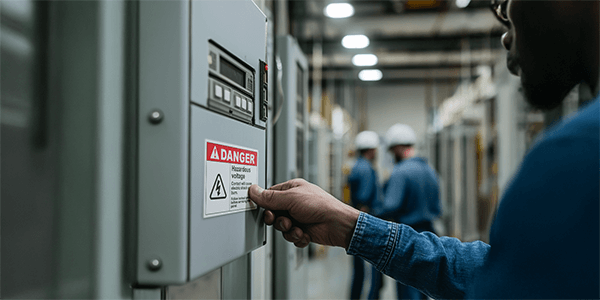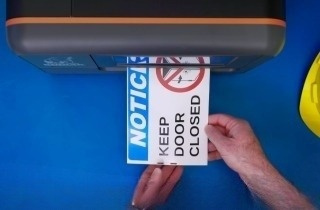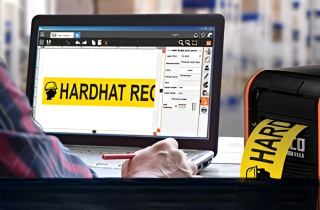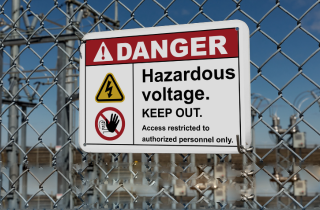Essential Electrical Labeling for OSHA Electrical Safety Training

Why Is Standardized and Durable Labeling Important in Electrical Work?
Standardized and durable labeling is important in electrical work because precision depends on clear, reliable identification. When panel schedules, conduit markings, and breakers are labeling consistently and built to last, electricians work faster and with fewer errors. This supports Occupational Health and Safety Administration (OSHA) electrical safety training by reducing confusion, limiting troubleshooting delays, and helping teams maintain safe, dependable systems.
The sections below explain how labeling supports safe electrical work, where failures cause risk, and what OSHA electrical safety standards expect.
-
Why durable materials matter in electrical environments
-
How labeling reduces delays and troubleshooting
-
Where unclear labels create safety risks
-
How labeling supports OSHA electrical safety standards and training
With that baseline in place, the rest of this section looks at where labeling adds the most safety and efficiency value, especially in panels and circuits that are serviced often or exposed to harsh conditions.
Panel Labeling Under OSHA Electrical Safety Standards
Electrical panels serve as command centers for multiple circuits within a building. A panel schedule records circuit functions, loads, and locations, helping electrical professionals reduce errors, quickly locate issues, and save time during maintenance, equipment upgrades, or electrical infrastructure modifications.
In large commercial and industrial environments, electrical systems often manage hundreds of circuits. Without a properly labeled panel schedule, electrical professionals must trace circuits by hand—a time-consuming process. A clear, updated directory eliminates guesswork and simplifies circuit identification and maintenance.
Why Electrical Labeling and Panel Identification Matter
The National Electrical Code (NEC) requires electrical panel directories to clearly identify each circuit’s function. NEC Article 408.4 mandates that labels remain legible, accurate, and regularly updated. Circuit identification must be specific—generic labels like "Lights" or "Plugs" do not meet compliance standards. Additionally, labels for electrical panels must be permanent and fade-resistant, as handwritten notes or labels do not provide long-term reliability.
A well-maintained electrical labeling system improves electrical management in several key ways:
- Faster troubleshooting: Electrical professionals can quickly identify circuits, reducing downtime and preventing errors.
- Improved efficiency: Labeled circuits simplify system modifications, eliminating unnecessary wire tracing.
- Improved workflow: An updated directory helps workers navigate panels efficiently during maintenance and upgrades.
Labeling Conduits for Better Wiring Organization
Electrical conduits protect and organize wiring systems, but as electrical networks grow in complexity, proper electrical labeling becomes crucial for maintaining accuracy and efficiency. Unclear conduit labeling can lead to misrouted connections, maintenance delays, and code violations. Unmarked conduits also increase the risk of accidental cross-wiring, which can result in electrical faults. By implementing a structured labeling system, professionals can simplify troubleshooting, prevent errors, and maintain an efficient electrical infrastructure.
To improve wiring organization, industry professionals can take several steps to streamline their processes:
- Standardize labeling practices: Maintain uniform label formats, font sizes, and placement to ensure clarity across all conduit pathways.
- Use color-coded labels: Assign specific colors to different wiring types, voltage levels, and functions to simplify identification.
- Choose durable, high-contrast labels: Select materials that withstand moisture, heat, and chemical exposure to maintain readability over time.
- Place labels at key locations: Mark junction boxes, entry and exit points, and regular intervals along conduit pathways for maximum visibility.
- Keep labels up to date: Review and update conduit labels to accurately reflect modifications or expansions.
Many industrial facilities use color-coded conduit labeling systems to indicate wire types, voltage levels, and destinations. Labels should appear at regular intervals, junction points, and termination locations to maintain visibility throughout the system. Following best practices for conduit labeling keeps wiring systems organized and simplifies future modifications.
How to Improve Breaker Labeling to Meet OSHA Electrical Safety Standards

Circuit breakers regulate electrical flow and serve as critical shutoff points in emergencies. Accurate labeling ensures quick identification. When labels are missing or unclear, electrical professionals may struggle to locate breakers, increasing downtime and the risk of errors.
During an electrical fault or fire, first responders and maintenance crews rely on breaker labels to deactivate specific circuits quickly. Without clear labels, responders can waste valuable time identifying the correct breaker, increasing the risk of electrical damage and safety hazards.
To improve efficiency, facilities should implement a standardized labeling system that ensures each breaker corresponds to a well-documented directory. This proactive approach supports both emergency response efforts and routine electrical maintenance, keeping workplaces organized and efficient.
Circuit breakers regulate electrical flow and serve as critical shutoff points in emergencies. Accurate labeling ensures quick identification. When labels are missing or unclear, electrical professionals may struggle to locate breakers, increasing downtime and the risk of errors.
During an electrical fault or fire, first responders and maintenance crews rely on breaker labels to deactivate specific circuits quickly. Without clear labels, responders can waste valuable time identifying the correct breaker, increasing the risk of electrical damage and safety hazards.
To improve efficiency, facilities should implement a standardized labeling system that ensures each breaker corresponds to a well-documented directory. This proactive approach supports both emergency response efforts and routine electrical maintenance, keeping workplaces organized and efficient.
Effective breaker labeling provides multiple benefits:
- Faster circuit isolation: Labeled breakers eliminate the need for time-consuming tracing when modifications or repairs are required.
- Simplified panel navigation: A clearly labeled directory allows professionals to locate and manage circuits efficiently.
- Easy system updates: Keeping breaker labels current supports smooth circuit modifications and system expansions.
- Long-term durability: Labels must resist environmental conditions like heat, moisture, and chemical exposure to maintain readability over time.
To maintain accuracy, facilities should establish routine audits and update labels whenever modifications occur. Digital documentation of the labeling system can help electrical contractors cross reference circuits quickly, reducing errors and improving long-term organization. By following these best practices, facilities can optimize workflow and maintain a well-organized electrical panel.
Electrical Labeling for Compliance and Longevity
Labels for electrical panels must withstand environmental conditions such as heat, moisture, and exposure to chemicals. Industry standards recommend the use of durable, fade-resistant materials to ensure long-term legibility. Electrical panel labeling that degrades over time can result in improper identification, requiring additional time for verification and increasing the potential for mistakes.
For wire and cable identification, self-laminating wraps or heat-shrink tubing are commonly used to protect labels from wear and environmental exposure. These solutions help maintain readability over time, ensuring critical electrical components remain clearly marked.
Proper electrical labeling is also a regulatory requirement. The American National Standards Institute (ANSI) and Occupational Health and Safety Administration (OSHA) provide guidelines on electrical identification, requiring all components to be permanently marked and easily readable. In industrial environments, non-compliance can lead to regulatory penalties and increased risk of equipment damage or injury.
In addition to general labeling standards, professionals should also comply with arc flash label requirements. These requirements specify the necessary information and placement of labels warning workers of potential arc flash hazards. Incorporating compliant electrical safety signs and arc flash label requirements into your labeling program enhances workplace safety and ensures adherence to OSHA and NFPA 70E standards.
DuraLabel Electrical Safety Labeling Resources
A well-organized electrical system depends on clear, durable labeling. Standardized labeling of panel schedules, conduits, and circuit breakers minimizes troubleshooting time and streamlines system modifications. As electrical infrastructure evolves, properly marked electrical components help industry professionals efficiently manage complex systems, reducing delays and confusion.
Long-term efficiency requires investing in labeling solutions that withstand environmental challenges and maintain readability over time. Durable labels engineered with high-contrast and fade-resistant materials help prevent misidentification and errors, making system maintenance more manageable.
For comprehensive guidance, DuraLabel’s free Electrical Safety Quick Start Guide provides insights into best practices for electrical labeling, including arc flash label requirements and the use of electrical safety signs to maintain compliance. This guide helps industry professionals refine labeling techniques, improve documentation accuracy, and streamline panel organization. By following these best practices, professionals can enhance efficiency and reduce the risk of misidentified circuits, ensuring smooth operations across electrical infrastructure.
For those looking to further optimize workspace organization, DuraLabel’s free 5S Quick Start Guide offers a structured approach to improving efficiency through standardized labeling and organization. This resource builds on electrical safety principles, helping professionals streamline labeling processes and enhance workflow efficiency. Get your free copy today.
Do you have questions about labeling solutions for your electrical system? Our safety professionals are ready to help. Whether you need guidance on compliance, best practices, or selecting the right materials for your facility, we provide expert support tailored to your needs. Call us today at 1-888-973-2045 and take the first step toward a more organized and compliant electrical system.
Read Next:
ANSI TIA 606-B Cable Labeling Standards
Electrical Conduit Labels: Why Choosing the Right Markers Makes All the Difference
Related Resources

Electrical Hazard Prevention Starts with Awareness
Why Is Electrical Safety Awareness Important in Every Workplace? Electrical safety awareness is essential for ...
Read
The Importance of Electrical Labeling for Electrical Installations
Why Is Electrical Labeling Important for Electrical Installations? Electrical installations require more than ...
Read
Miswired and Mislabeled: The Electrical Errors That Could Cost You
Electrical failures and malfunctions remain a major safety concern, causing injuries, fatalities, and ...
Read.png)





